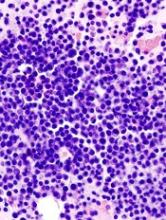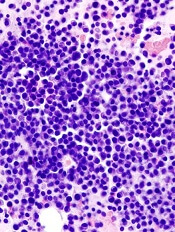User login
Researchers say they have developed a computational platform that can be used to identify optimal treatments for multiple myeloma (MM).
Using this tool, the quadratic phenotypic optimization platform (QPOP), the researchers identified a 2-drug combination that proved effective against bortezomib-resistant MM in vitro.
The combination—decitabine and mitomycin C—also decreased tumor volume and prolonged survival in a mouse model of bortezomib-resistant MM.
Masturah Bte Mohd Abdul Rashid, of the Cancer Science Institute of Singapore, and her colleagues reported these results in Science Translational Medicine.
The researchers explained that QPOP approximates biological responses to therapies using advanced mathematical equations. Unlike conventional models, QPOP doesn’t require predetermined information about the mechanisms or composition of a drug.
To test QPOP’s utility in MM, the researchers began by identifying candidate drugs that might be effective against bortezomib-resistant MM. They screened 114 approved oncology drugs on 2 MM cell lines—RPMI 8226 and bortezomib-resistant RPMI 8226 (P100v).
The drugs that proved most effective against P100v were dactinomycin, decitabine, mechlorethamine hydrochloride, and mitomycin C.
The researchers wanted to identify optimal drug combinations, so they conducted a QPOP analysis including the 4 most effective drugs and an additional 10 drugs used to treat MM. The 10 drugs were bortezomib, carfilzomib, cyclophosphamide monohydrate, dexamethasone, doxorubucin, lenalidomide, panobinostat, plerixafor, thalidomide, and zoledronic acid.
The team tested 2 dosages of the 14 drugs in 128 combinations, then narrowed the list to 9 drugs and tested them at 3 dosages in 155 combinations.
This revealed the top 3 combinations:
- Decitabine and mitomycin C
- Mechlorethamine hydrochloride, decitabine, and mitomycin C
- Bortezomib, mechlorethamine hydrochloride, and mitomycin C.
The researchers said these combinations act by reversing the DNA methylation and tumor suppressor silencing that often occurs after acquired bortezomib resistance.
The team noted that the top 3 combinations had synergistic interactions, but the QPOP analysis revealed antagonistic interactions as well. For example, bortezomib and dexamethasone proved antagonistic, as did bortezomib and panobinostat.
The researchers conducted further testing to determine the optimal dosage of decitabine and mitomycin C. Results suggested both drugs should be given at 1.5 mg/kg.
The team then treated P100v tumor-bearing mice with decitabine and mitomycin C, both at 1.5 mg/kg, either alone or in combination.
Mice that received the combination had a decrease in tumor size and prolonged survival compared to mice that received DMSO (P=0.0130), decitabine alone (P=0.0121), or mitomycin C alone (P=0.00174).
The researchers also compared decitabine and mitomycin C in combination to 2 bortezomib-based combinations used to treat MM—bortezomib/dexamethasone/melphalan and bortezomib/dexamethasone/lenalidomide—in P100v tumor-bearing mice.
There was a significant decrease in tumor volume with decitabine/mitomycin C compared to bortezomib/dexamethasone/melphalan (P=0.000376) and bortezomib/dexamethasone/lenalidomide (P=0.000691).
Mice that received decitabine/mitomycin C had significantly longer survival than mice that received bortezomib/dexamethasone/melphalan (P=0.0389) or bortezomib/dexamethasone/lenalidomide (P=0.0246).
Neither survival times nor tumor volumes were significantly different between the mice that received DMSO and those that received either of the bortezomib-based combinations.
Researchers say they have developed a computational platform that can be used to identify optimal treatments for multiple myeloma (MM).
Using this tool, the quadratic phenotypic optimization platform (QPOP), the researchers identified a 2-drug combination that proved effective against bortezomib-resistant MM in vitro.
The combination—decitabine and mitomycin C—also decreased tumor volume and prolonged survival in a mouse model of bortezomib-resistant MM.
Masturah Bte Mohd Abdul Rashid, of the Cancer Science Institute of Singapore, and her colleagues reported these results in Science Translational Medicine.
The researchers explained that QPOP approximates biological responses to therapies using advanced mathematical equations. Unlike conventional models, QPOP doesn’t require predetermined information about the mechanisms or composition of a drug.
To test QPOP’s utility in MM, the researchers began by identifying candidate drugs that might be effective against bortezomib-resistant MM. They screened 114 approved oncology drugs on 2 MM cell lines—RPMI 8226 and bortezomib-resistant RPMI 8226 (P100v).
The drugs that proved most effective against P100v were dactinomycin, decitabine, mechlorethamine hydrochloride, and mitomycin C.
The researchers wanted to identify optimal drug combinations, so they conducted a QPOP analysis including the 4 most effective drugs and an additional 10 drugs used to treat MM. The 10 drugs were bortezomib, carfilzomib, cyclophosphamide monohydrate, dexamethasone, doxorubucin, lenalidomide, panobinostat, plerixafor, thalidomide, and zoledronic acid.
The team tested 2 dosages of the 14 drugs in 128 combinations, then narrowed the list to 9 drugs and tested them at 3 dosages in 155 combinations.
This revealed the top 3 combinations:
- Decitabine and mitomycin C
- Mechlorethamine hydrochloride, decitabine, and mitomycin C
- Bortezomib, mechlorethamine hydrochloride, and mitomycin C.
The researchers said these combinations act by reversing the DNA methylation and tumor suppressor silencing that often occurs after acquired bortezomib resistance.
The team noted that the top 3 combinations had synergistic interactions, but the QPOP analysis revealed antagonistic interactions as well. For example, bortezomib and dexamethasone proved antagonistic, as did bortezomib and panobinostat.
The researchers conducted further testing to determine the optimal dosage of decitabine and mitomycin C. Results suggested both drugs should be given at 1.5 mg/kg.
The team then treated P100v tumor-bearing mice with decitabine and mitomycin C, both at 1.5 mg/kg, either alone or in combination.
Mice that received the combination had a decrease in tumor size and prolonged survival compared to mice that received DMSO (P=0.0130), decitabine alone (P=0.0121), or mitomycin C alone (P=0.00174).
The researchers also compared decitabine and mitomycin C in combination to 2 bortezomib-based combinations used to treat MM—bortezomib/dexamethasone/melphalan and bortezomib/dexamethasone/lenalidomide—in P100v tumor-bearing mice.
There was a significant decrease in tumor volume with decitabine/mitomycin C compared to bortezomib/dexamethasone/melphalan (P=0.000376) and bortezomib/dexamethasone/lenalidomide (P=0.000691).
Mice that received decitabine/mitomycin C had significantly longer survival than mice that received bortezomib/dexamethasone/melphalan (P=0.0389) or bortezomib/dexamethasone/lenalidomide (P=0.0246).
Neither survival times nor tumor volumes were significantly different between the mice that received DMSO and those that received either of the bortezomib-based combinations.
Researchers say they have developed a computational platform that can be used to identify optimal treatments for multiple myeloma (MM).
Using this tool, the quadratic phenotypic optimization platform (QPOP), the researchers identified a 2-drug combination that proved effective against bortezomib-resistant MM in vitro.
The combination—decitabine and mitomycin C—also decreased tumor volume and prolonged survival in a mouse model of bortezomib-resistant MM.
Masturah Bte Mohd Abdul Rashid, of the Cancer Science Institute of Singapore, and her colleagues reported these results in Science Translational Medicine.
The researchers explained that QPOP approximates biological responses to therapies using advanced mathematical equations. Unlike conventional models, QPOP doesn’t require predetermined information about the mechanisms or composition of a drug.
To test QPOP’s utility in MM, the researchers began by identifying candidate drugs that might be effective against bortezomib-resistant MM. They screened 114 approved oncology drugs on 2 MM cell lines—RPMI 8226 and bortezomib-resistant RPMI 8226 (P100v).
The drugs that proved most effective against P100v were dactinomycin, decitabine, mechlorethamine hydrochloride, and mitomycin C.
The researchers wanted to identify optimal drug combinations, so they conducted a QPOP analysis including the 4 most effective drugs and an additional 10 drugs used to treat MM. The 10 drugs were bortezomib, carfilzomib, cyclophosphamide monohydrate, dexamethasone, doxorubucin, lenalidomide, panobinostat, plerixafor, thalidomide, and zoledronic acid.
The team tested 2 dosages of the 14 drugs in 128 combinations, then narrowed the list to 9 drugs and tested them at 3 dosages in 155 combinations.
This revealed the top 3 combinations:
- Decitabine and mitomycin C
- Mechlorethamine hydrochloride, decitabine, and mitomycin C
- Bortezomib, mechlorethamine hydrochloride, and mitomycin C.
The researchers said these combinations act by reversing the DNA methylation and tumor suppressor silencing that often occurs after acquired bortezomib resistance.
The team noted that the top 3 combinations had synergistic interactions, but the QPOP analysis revealed antagonistic interactions as well. For example, bortezomib and dexamethasone proved antagonistic, as did bortezomib and panobinostat.
The researchers conducted further testing to determine the optimal dosage of decitabine and mitomycin C. Results suggested both drugs should be given at 1.5 mg/kg.
The team then treated P100v tumor-bearing mice with decitabine and mitomycin C, both at 1.5 mg/kg, either alone or in combination.
Mice that received the combination had a decrease in tumor size and prolonged survival compared to mice that received DMSO (P=0.0130), decitabine alone (P=0.0121), or mitomycin C alone (P=0.00174).
The researchers also compared decitabine and mitomycin C in combination to 2 bortezomib-based combinations used to treat MM—bortezomib/dexamethasone/melphalan and bortezomib/dexamethasone/lenalidomide—in P100v tumor-bearing mice.
There was a significant decrease in tumor volume with decitabine/mitomycin C compared to bortezomib/dexamethasone/melphalan (P=0.000376) and bortezomib/dexamethasone/lenalidomide (P=0.000691).
Mice that received decitabine/mitomycin C had significantly longer survival than mice that received bortezomib/dexamethasone/melphalan (P=0.0389) or bortezomib/dexamethasone/lenalidomide (P=0.0246).
Neither survival times nor tumor volumes were significantly different between the mice that received DMSO and those that received either of the bortezomib-based combinations.

